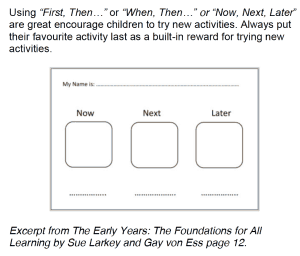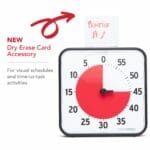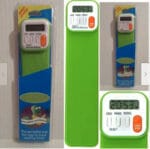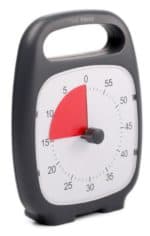Transition from One Activity to Another
 Many children with ASD have difficulties accepting change and transition from one activity to another. In fact, most behaviour happens during change/transition. In my experience this is because it requires problem solving, choices and adults tend to use more verbal information instead of visual information. It can also be a time of movement and high noise level, which can cause sensory processing difficulties. Below I have listed some key times you may need to put in place strategies to support children during change.
Many children with ASD have difficulties accepting change and transition from one activity to another. In fact, most behaviour happens during change/transition. In my experience this is because it requires problem solving, choices and adults tend to use more verbal information instead of visual information. It can also be a time of movement and high noise level, which can cause sensory processing difficulties. Below I have listed some key times you may need to put in place strategies to support children during change.
 The KEY – Planning the Transition.
The KEY – Planning the Transition.
Download One Page of Transition Examples and Suggested Strategies
Tip Sheet – Managing Transition Between Actitives
|
Transition Example Activity / Behaviour |
Structural Change Routine Change |
|
Pack away / finish activity |
Give five minute warning. Use a Time Timer (see below)so can visually see ‘how long’. Use a visual schedule that shows what is happening throughout the day or use ‘Now, Next, Later’ visual to tell them when they will return to a preferred activity.
|
|
Choose an activity |
Minimise the choices i.e. instead of a whole shelf of puzzles or books have two puzzles or two books. Give real choices e.g. do your homework now or after dinner. |
|
Lining up |
Have a set spot in the line, and set partner. This can change each week. Have the ‘other child’ be a supportive peer who will help them line up in the correct place. Let them stand with an adult or give a job to do e.g. hold equipment or count students. |
|
Find a partner / friend |
Set partner. Get the partner to go to the ASD child, so they don’t have to find them. (Be careful using the word ‘friend’ as they may perceive they don’t have any.) |
|
Giving instructions to change activity |
Use visuals to support language. Use Signing (everyone uses different gesture or words to mean pack away, so sign ‘FINISH’ which is more universal). Use pictures to support language (Pics for PECS is a GREAT and reasonably priced visual system). |
|
Sensory issues |
Movement, noise, touch, smell can all create sensory issues for students with ASD. Be aware of any sensory triggers, i.e. whistle to stop activity, bell to go inside, touch at line, or tote boxes/lockers, singing at assembly, food smells at eating time. See sensory books page 6 to understanding sensory and strategies. |
|
Feeling out of control / wanting control |
A schedule helps them see and understand what is going to happen next. Schedules also help people with ASD to organise themselves and to plan ahead. |
|
Sit on mat |
Have set spot. Use a sensory mat to sit on (see page 7). Let them sit in teacher’s chair or have a job to help the teacher. |
|
Outside / inside Home / school |
Often they are so involved in an activity they don’t want to leave it. This is where the importance of timers, clocks, and pre-warning is VITAL. Always tell them when they will get to return to preferred activities i.e. “When you eat lunch, then you can ……….” |
Recommended Resources to help with Transition
Time Timers
Used as an interactive teaching tool, this class-room tested teaching aide reinforces the sense of elapsed time with a graphic depiction of the time remaining. The Time Timer can be used to set time limits, measure the duration of activities and train students to make better use of time available. They are the ideal solution for anyone who struggles with time – as time elapses the signature red disk disappears, creating a clear and simple picture of the time remaining. A great way to promote efficient time management at work, school and home.
More Timers









 Sorry we no longer ship items outside Australia. Please consider the digital versions of Sue’s Books –
Sorry we no longer ship items outside Australia. Please consider the digital versions of Sue’s Books – 